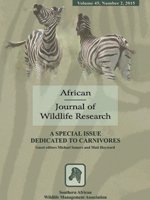Much of Africa comprises arid regions, yet little is known about the ecological interactions between large carnivores in these landscapes. A review of the densities, feeding and foraging ecology, as well as the relations between the large carnivores in the arid Kalahari, illustrates how they have successfully adapted to arid conditions, and highlights some of the differences in these relationships with those in more mesic areas. In the arid Kalahari, the relative densities of the large carnivores are more even, but community structure is different, with the inclusion of the brown hyaena (Hyaena brunnea) and the disappearance of the African wild dog (Lycaon pictus). Resource partitioning is more acute and diet flexibility is evident. The relative contribution to animals killed by predation is more equitably shared by the predator community, and high rates of food loss by smaller carnivores to larger ones has not been recorded. There is even an example of a smaller carnivore (brown hyaena) deriving benefits from a larger one (lion, Panthera leo). Arid regions are clearly important areas for large carnivores and more attention should be given to research and conservation of carnivores in arid areas.
How to translate text using browser tools
1 September 2015
Living Near the Edge: A Review of the Ecological Relationships Between Large Carnivores in the Arid Kalahari
Michael G.L. Mills
ACCESS THE FULL ARTICLE
Arid regions
carnivores
ecological interactions





